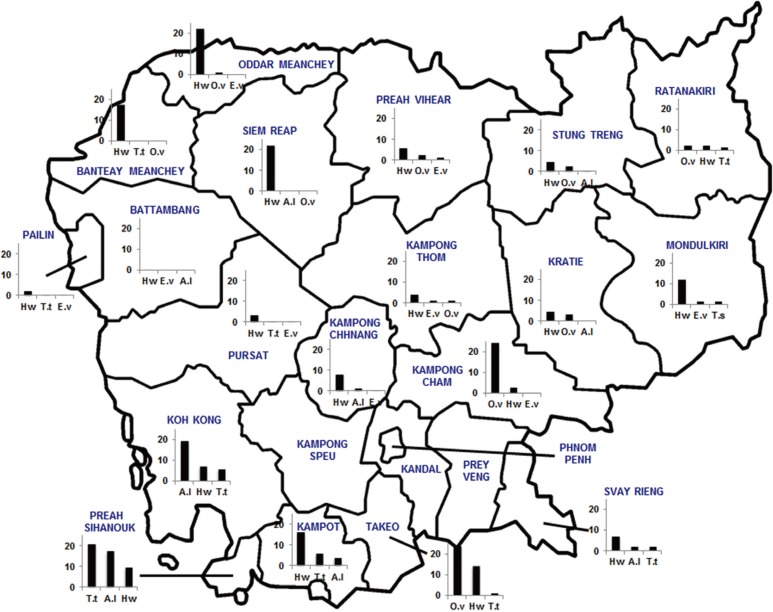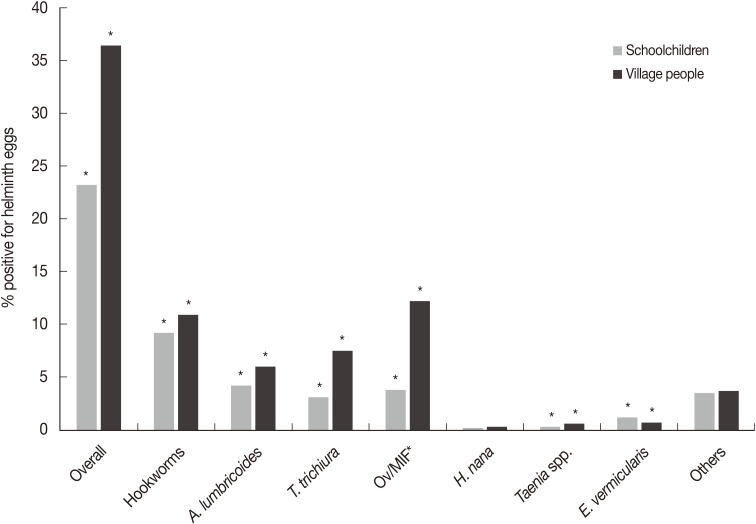Prevalence of Intestinal Helminths among Inhabitants of Cambodia (2006-2011)
Article information
Abstract
In order to investigate the status of intestinal helminthic infections in Cambodia, epidemiological surveys were carried out on a national scale, including 19 provinces. A total of 32,201 fecal samples were collected from schoolchildren and adults between 2006 and 2011 and examined once by the Kato-Katz thick smear technique. The overall egg positive rate of intestinal helminths was 26.2%. The prevalence of hookworms was the highest (9.6%), followed by that of Opisthorchis viverrini/minute intestinal flukes (Ov/MIF) (5.7%), Ascaris lumbricoides (4.6%), and Trichuris trichiura (4.1%). Other types of parasites detected were Enterobius vermicularis (1.1%), Taenia spp. (0.4%), and Hymenolepis spp. (0.2%). The northwestern regions such as the Siem Reap, Oddar Meanchey, and Banteay Meanchey Provinces showed higher prevalences (17.4-22.3%) of hookworms than the other localities. The southwestern areas, including Koh Kong and Preah Sihanouk Provinces showed higher prevalences of A. lumbricoides (17.5-19.2%) and T. trichiura (6.1-21.0%). Meanwhile, the central and southern areas, in particular, Takeo and Kampong Cham Provinces, showed high prevalences of Ov/MIF (23.8-24.0%). The results indicate that a considerably high prevalence of intestinal helminths has been revealed in Cambodia, and thus sustained national parasite control projects are necessary to reduce morbidity due to parasitic infections in Cambodia.
INTRODUCTION
Cambodia is a tropical country located in the southern part of the Indochina Peninsula in Southeast Asia. Cambodia has an area of 181,035 square kilometers and lies entirely within the tropics, and its climate is dominated by monsoons, which are known as tropical wet and dry conditions because of the marked seasonal differences. It is bordered by Thailand to the west, Laos to the northeast, and Vietnam to the east. The total population is approximately 14.8 million. Administratively, Cambodia is divided into 24 provinces, including the capital Phnom Penh; the political, economic, and cultural center of Cambodia.
There were a few local reports on intestinal helminth infections of public health importance in Cambodia, including soil-transmitted nematodes and food-borne trematodes [1,2]. There also were some reports that described the prevalence of a particular parasite, for example, Strongyloides stercoralis; it was rather frequently detected in 20.2% of children in villages bordering Tonle Sap Lake [2] and in 18.6-24.4% of children in Kandal Province [3]. In Kratie and Stung Treng Provinces, Schistosoma mekongi was reported to be fairly endemic [4]. In addition, high prevalences of Opisthorchis viverrini infection were reported in Takeo [5], Kratie [6], Kandal, Kampong Cham, and Kampong Thom Provinces [7].
Nevertheless, national scale data on the prevalence of intestinal helminths are yet unavailable, although control programmes with mass deworming directed to schoolchildren were launched on a large scale some ~15 years ago [8]. In the meantime, a Korea-Cambodia collaborative project on intestinal parasite control in schoolchildren and village people was started in 2006 and continued until 2011. The objectives of the project were survey and elimination of intestinal helminth infections and strengthening of the health care delivery system. This report summarizes the fecal survey results obtained during the 6-year collaborative project between Korea and Cambodia.
MATERIALS AND METHODS
Surveyed areas
Fecal specimens were collected from a total of 32,201 subjects (male/female=0.9) from 19 provinces, including 24,892 schoolchildren (6-12 years) and 7,309 adults (>15 years). The provinces surveyed were grouped into 4 categories, including northwestern (Banteay Meanchey, Battambang, Oddar Meanchey, Pailin, Preah Vihear, and Siem Reap), southwestern (Kampot, Koh Kong, and Preah Sihanouk), eastern (Kratie, Mondulkiri, Ratanakiri, and Stung Treng), and central and southern provinces (Kampong Cham, Kampong Chhnang, Kampong Thom, Pursat, Svay Rieng, and Takeo).
Fecal examination
Fecal specimens were examined once for intestinal helminth eggs by the Kato-Katz thick smear technique. The ethical aspects of the fecal survey were approved by the Ministry of Health, Cambodia under the agreement of the Korea-Cambodia International Collaboration on Intestinal Parasite Control in Cambodia (2006-2011).
Statistical analysis
The prevalences of hookworms and other helminths were compared between different provinces and between schoolchildren and adults, and results were statistically evaluated by the chi-square test. The P-values of <0.05 were considered statistically significant.
RESULTS
The overall average helminth egg positive rate among the surveyed people was 26.2% (8,449 positive cases among 32,201 subjects examined) and the rate varied from 5.5% to 44.1% among different provinces (Table 1). The rate was highest in the Takeo Province (44.1%), followed by the Preah Sihanouk (39.8%), Kampong Cham (31.7%), and Koh Kong Provinces (31.5%). The lowest positive rate was observed in the Battambang Province (5.5%), followed by the Pailin (5.7%) and Kampong Thom Provinces (8.2%).
Among the helminth species detected, hookworms (including Ancylostoma duodenale, A. ceylanicum, and Necator americanus) were the most highly prevalent species with an average egg positive rate of 9.6% (Table 1). The second most prevalent species was O. viverrini/minute intestinal fluke (Ov/MIF; 5.7%) followed by Ascaris lumbricoides (4.6%), Trichuris trichiura (4.1%), Enterobius vermicularis (1.1%), Taenia spp. (0.4%), and Hymenolepis nana (0.2%). Other kinds of helminth eggs detected were Trichostrongylus sp., Hymenolepis diminuta, echinostomes, dicrocoelids, and fasciolids.
The prevalence of hookworms varied among the different provinces surveyed (Table 1; Fig. 1). The rate was highest in Oddar Meanchey Province, followed by Siem Reap and Banteay Meanchey Provinces, all of which are located in the northwestern area of Cambodia (Fig. 1). The next highest rates were detected in Kampot, Takeo, and Mondulkiri Provinces. The prevalence of Ov/MIF eggs was highest in Kampong Cham Province, followed by Takeo, Kratie, Ratanakiri, Preah Vihear, and Stung Treng Provinces. The prevalences of A. lumbricoides and T. trichiura were highest in southwestern provinces, in particular, Preah Sihanouk and Koh Kong Provinces. Kampot Province also showed comparatively high prevalences of A. lumbricoides and T. trichiura. All other provinces showed prevalences of 0-2.0% for these nematodes.

Map of Cambodia showing the prevalence of intestinal helminths (3 most important species in each province) during 2006 and 2011. Note that hookworms are highly prevalent particularly in the northwestern provinces (Oddar Meanchey, Banteay Meanchey, and Siem Reap) followed by the southwestern provinces (Koh Kong and Kampot). O. viverrini/minute intestinal flukes (MIF) are prevalent in the Kampong Cham and Takeo Provinces. Hw, hookworms; A.l., Ascaris lumbricoides; T. t., Trichuris trichiura; O.v., Opisthorchis viverrini/MIF; E.v., Enterobius vermicularis; T.s., Taenia spp..
Taenia spp. eggs were detected in fecal samples collected from 13 provinces. The highest prevalence was found in Koh Kong and Mondulkiri Provinces, followed by Ratanakiri, Preah Vihear, and Svay Rieng Provinces. H. nana eggs were detected in a few fecal samples collected from 9 provinces, including Mondulkiri, Ratanakiri, and Koh Kong Provinces. Eggs of E. vermicularis were detected in fecal samples collected from all provinces except Stung Treng, and the egg positive rate ranged from 0.2% to 1.8% (Kampot Province). There were a substantial number of positive cases for eggs of Trichostrongylus sp., H. diminuta, echinostomes, dicrocoelids, and fasciolids.
The prevalence of helminth eggs was slightly different between schoolchildren and adults. The overall average egg positive rate was notably higher (P<0.05) in adults (36.4%) than in schoolchildren (23.2%) (Fig. 2). Adults showed significantly (P<0.05) higher prevalences of hookworms, A. lumbricoides, T. trichiura, Ov/MIF, and Taenia spp. compared with schoolchildren. However, the prevalence of E. vermicularis was significantly higher (P<0.05) in schoolchildren than in adults. No age difference was noted between subjects infected with H. nana and other kinds of parasites. There was no significant gender difference in the prevalence of these helminths (data not shown).

Comparative prevalence of intestinal helminths between schoolchildren and adults in 19 provinces, Cambodia (2006-2011). The overall egg positive rates of helminths, hookworms, A. lumbricoides, T. trichiura, O. viverrini/MIF, and Taenia spp. were significantly (P<0.05) higher in adults than in schoolchildren. Conversely, the prevalence of E. vermicularis was significantly (P<0.05) higher in schoolchildren than in village people. Others included Trichostrongylus sp., Hymenolepis diminuta, echinostomes, dicrocoelids, and fasciolids.
DISCUSSION
The present study revealed a considerably high prevalence of intestinal helminths (average 26.2%) among schoolchildren and village people in 19 provinces of Cambodia. The areas covered were located almost nationwide, and some apparent trends could be seen from the results. First of all, hookworms appeared to be the most important helminth species with an average egg positive rate of 9.6%. The prevalence of hookworms was slightly but significantly higher in adults than in schoolchildren. This finding was different from the general trend; children show a higher prevalence than adult population. This may be due to the recent national helminth control programmes in Cambodia that mostly covered schoolchildren [8,9]. These control programs may also have exerted some effects on the different levels of prevalence by different survey areas.
Based on molecular epidemiologic surveys, N. americanus and A. ceylanicum are the 2 most common hookworm species infecting humans in Asia [10]. In Thailand, Laos, and Malaysia, 6-23% of persons positive for hookworm eggs were infected with A. ceylanicum [10]. In a rural village of Preah Vihear Province, Cambodia, 47.6% of hookworm egg positive cases were molecularly diagnosed as N. americanus infection and 46.0% were confirmed as A. ceylanicum infection; only 3.2% were found infected with A. duodenale [10]. Viewing from this report, we could speculate that the hookworm egg positive cases in our study were infected predominantly with N. americanus and A. ceylanicum, and only a small proportion may be A. duodenale. However, this trend should be confirmed by surveys in each hookworm endemic area.
A striking feature of this survey was that the prevalence of A. lumbricoides was lower than that of hookworms in most of the surveyed areas except for Koh Kong and Preah Sihanouk Provinces. This finding was different from the previous results. For example, in primary schoolchildren in Kampong Cham Province, the prevalence of hookworms was 6.4%, whereas that of A. lumbricoides was 26.3% [11]. Similarly, in schoolchildren in Kratie Province, the prevalence of hookworms was 28.9% and that of A. lumbricoides was 49.0% [1]. On the other hand, similar prevalences were observed for hookworms and A. lumbricoides among schoolchildren and adolescents in 5 provinces bordering the Tonle Sap Lake [2]. A trend similar to our results was also reported; in a provincial hospital in Siem Reap Province, the egg positive rate of hookworms was 5.1% among the 16,372 children examined, while that of A. lumbricoides was only 0.3% [12]. It is suggested that soil-transmitted helminths, in particular, A. lumbricoides and T. trichiura were found to be under control owing to the recent national helminth control programmes directed to schoolchildren in Cambodia [8,9].
Strongyloides stercoralis, another species of soil-transmitted helminths, was excluded from our survey because we used the Kato-Katz fecal examination technique which cannot detect the larvae of S. stercoralis. There are an increasing number of reports on S. stercoralis infection among children in Cambodia [2,3,9]. In Kandal Province, the reported prevalence of S. stercoralis ranged from 18.6% to 24.4% based on the detection technique used; Koga agar plate culture versus Baermann technique [3]. A national survey is needed to determine the precise status of strongyloidiasis in Cambodia.
The liver fluke O. viverrini was not considered to be distributed in Cambodia until several recent studies that reported about its distribution [5,6,7,13,14]. Its metacercarial stage was first detected in various species of fresh water fish caught in southern Cambodia, including Takeo and Kandal Provinces [13], and confirmed human cases by adult worms were first reported in Takeo Province [14]. Subsequently, endemic foci of human opisthorchiasis were found in Takeo [5], Kratie [6], Kandal, Kampong Cham, and Kampong Thom Provinces [7]. The present study suggests several more provinces, including Preah Vihear, Ratanakiri, and Stung Treng Provinces as low-grade endemic areas of opisthorchiasis in Cambodia.
Taenia spp. eggs were detected most frequently in the fecal samples collected from Koh Kong Province. In order to determine the species of Taenia in this area, we analyzed the cox1 gene isolated from the eggs, and the results (either T. saginata or T. solium) have been published separately [15]. The risk factors for Taenia infection in Koh Kong area remain to be elucidated. Some of the echinostome eggs were identified to be eggs of Echinostoma revolutum in Pursat Province [16] and Echinostoma ilocanum in Oddar Meanchey Province [17] through recovery of adult flukes after anthelmintic treatment and purging. Dicrocoelid eggs were detected in a few cases; however, these cases may be spurious infections caused by eating cattle liver infected with adult dicrocoelid flukes (e.g., Dicrocoelium dendriticum).
Regarding the prevalence of E. vermicularis, it should be reminded that the figures obtained in this study do not reflect the real status of infection because the examination was performed only by the Kato-Katz technique in this study. Therefore, the egg positive rate of E. vermicularis (av. 1.1%) obtained must have been an underestimated value. To cope with this problem, the cello-tape anal swab technique should be applied which can detect E. vermicularis eggs properly.
Conclusively, hookworms, followed by Ov/MIF, A. lumbricoides, and T. trichiura were found to be the most highly prevalent intestinal helminth among inhabitants of Cambodia. Sustained helminth control projects are necessary to further reduce morbidity due to parasitic infections in Cambodia.
ACKNOWLEDGMENTS
This project was supported by the Korea International Cooperation Agency and Korea Association of Health Promotion, Seoul, Korea, and Centers for Parasitology, Entomology, and Malaria Control, Ministry of Health, Phnom Penh, Cambodia. We are grateful to the staff of Center for Parasitology, Entomology, and Malaria Control for their assistance in collecting fecal specimens and preparing the Kato-Katz fecal smears. We also thank the staff of Korea Association of Health Promotion, who participated in the Korea-Cambodia Cooperation Project on Parasite Control in Cambodia (2006-2011), particularly for reading the Kato-Katz fecal smears.
Notes
We have no conflict of interest related to this work.
